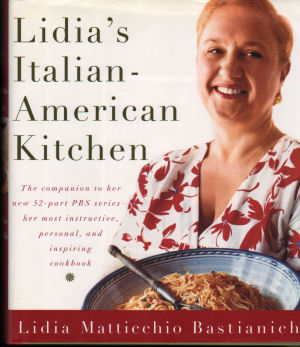 Homepage
Sitemap
Site Search
Homepage
Sitemap
Site Search

Lidia's Italian American Kitchen, by Lidia Bastianich; Alfred A. Knoff, New York, 2001
Lidia's Italian American Kitchen is going to
stand the test of time like many cookbooks written by James Beard,
Julia Child and Craig Claiborne. There may be other Italian
cookbooks that will too but this one carries Lidia's personality and
is the companion book to her PBS television series.
The book
is hefty but manageable enough to pick up and flip through the
pages, yet you might get tired holding it. I prefer to rest it on
the kitchen counter for referencing the recipes such as Baked
Stuffed Shells, Linguini with Bacon and Onions (aka Linguini alla
Carbonara) and veal Marsala. There are also appetizers, soups, salad
and desserts and other Italian American favorites to choose from.
The book is well written with fairly easy to follow recipes,
that yield excellent results in Lidia's style of cooking. Her style
is professional and she really cares about how her food tastes! For
you to be successful with her recipe you should have some experience
in cooking Italian dishes so you'll be able to relate to the
instruction. It would also be helpful to have eaten in a few really
good Italian restaurants so that you have a perspective on how
Italian cooks use seasonings, particularly garlic and oregano.
Look at some of the recipes you will find in the cookbook---
This is one of the best American cookbooks ever written!
It's a Good Cooking must buy/must have cookbook for any serious cookbook library.Linguine with Bacon and Onions
Makes 6 servings
The
Importance of Coarsely Ground Pepper: Coarsely ground black pepper is
essential to this dish. If your mill doesn't grind pepper coarsely. try
the following trick: Place the peppercorns on a flat surface. Holding
the rim of a small, heavy saucepan or skillet with one hand, and
pressing down on the center of the pan with the other, crush the
peppercorns until coarsely ground.
Salt
6 ounces slab
bacon, in 1 piece
2 tablespoons extra-virgin olive oil, plus more if
needed
2 large yellow onions, sliced 1/2 inch thick (about 3 cups)
1 1/2 cups hot Chicken Stock (page 74) or canned reduced-sodium chicken
broth, or as needed
1 pound linguine
3 egg yolks
1 cup freshly
grated Parmigiano-Reggiano cheese
Coarsely ground black pepper
I use slab bacon here because I like large pieces that are brown the
outside but still moist in the center. If you cannot find slab bacon,
use the thickest-sliced supermarket bacon you can find. Just be sure not
to overcook it. If you prefer; you can pour off all the bacon fat after
browning the bacon and replace it with an equal amount of olive oil, but
remember, the bacon fat has a much more pronounced flavor. If you don't
have the stock called for in the recipe, just use water from the pasta
pot.
Often you will see this dish prepared with cream. It's not the
traditional style, but that's not to say it doesn't taste good. But
I prefer my Carbonara made this way, the sauce thickened lightly
with egg yolk. The heat of the pasta is enough to cook the egg
yolks, but if you like, you may bring a small saucepan of boiling
water to a simmer and, about a minute before draining the pasta,
slip the yolks into a small sieve placed in the simmering water; to
coddle them for a minute. Carefully lift the sieve from the water
and add the coddled yolks to the pasta as described below.
Bring 6 quarts of salted water to the boil in an 8-quart pot over
high heat.
Remove the rind, if
necessary, from the bacon. Cut the bacon into 1/4-inch slices, then cut
the slices crosswise into 1/4-inch strips. Heat the olive oil in a
large, heavy skillet over medium heat. Add the bacon and cook, stirring,
until the bacon is lightly browned but still soft in the center, about 6
minutes.
The amount of fat in the skillet will vary depending on
the bacon. If there is more than 3 to 4 tablespoons of fat in the pan,
pour off the excess. If there is less than 3 to 4 tablespoons, add
enough olive oil to measure that amount. Add the onions and cook until
wilted but still crunchy, about 4 to 5 minutes. Add the stock, bring to
a boil, and adjust the heat to a lively simmer. Cook until the liquid is
reduced by about half.
Meanwhile, stir the linguine into the
boiling salted water. Return to a boil, stirring frequently. Cook the
pasta, semi-covered, stirring occasionally, until done, about 8 minutes.
Ladle off about a cup of the pasta-cooking water. If the skillet is
large enough to accommodate the sauce and pasta, fish the pasta out of
the boiling water with a large wire skimmer and drop it directly into
the sauce in the skillet. If not, drain the pasta, return it to the pot,
and pour in the sauce. Bring the sauce and pasta to a boil, stirring to
coat the pasta with sauce. Check the seasoning, adding salt if
necessary. If necessary; add as much chicken stock or pasta-cooking
water as needed to make enough sauce to coat the pasta generously.
Remove the pan from the heat and add the egg yolks one at a time,
tossing well after each. (A salad fork and spoon work well for this.)
Add the grated cheese, then the black pepper, tossing well, and serve
immediately in warmed bowls.